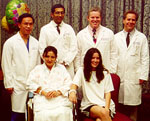
Return to Main Menu |
Mushroom-poisoned
teen released after transplant
Doctors at MUSC say it may be the first time a
living donor has been used for a transplant necessitated by mushrooms.
Editor's note: The following story was printed in The State newspaper
July 12. It is reprinted with permission.
by Carol J.G. Ward and Christina Lee Knauss,
Staff Writers
The search for a cheap high ended in a life-threatening situation for
a Sumter teen-ager last week.
Seventeen-year-old Brittany Frye and two friends went looking for so-called
magic mushrooms in a cow pasture. What they found and ingested, however,
was a toxic variety that destroyed Frye's liver.
 Members
of the Transplant team include from left: Drs. Angello Lin, Prabhakar K
Baliga, Kenneth Chavin and Jeffrey Rogers surround mother, Leisa and daughter,
Brittany Frye. Leisa was released from MUSC on Thursday, July 26. Members
of the Transplant team include from left: Drs. Angello Lin, Prabhakar K
Baliga, Kenneth Chavin and Jeffrey Rogers surround mother, Leisa and daughter,
Brittany Frye. Leisa was released from MUSC on Thursday, July 26.
She underwent a liver transplant in Charleston last week. Her mother,
Leisa, donated part of her liver for the transplant, which took place at
the Medical University of South Carolina. Doctors at MUSC say it's thought
to be the first time a living donor has been used for a transplant necessitated
by toxic mushrooms.
The whole experience has been a frightening eye-opener for the girl
and her father, James Frye, 38.
“I just didn't know how this could happen—how you could get liver failure
and be so close to death just from a mushroom,” Frye said in an interview
Wednesday afternoon. The girl ingested a glass of tea made with a handful
of small mushrooms around 3 a.m. on July 2, said Dr. Kenneth Chavin, a
liver transplant surgeon at MUSC. By the morning, she was treated for gastroenteritis
at Tuomey Regional Medical Center in Sumter and released.
Twenty-four hours later, Frye was back in the hospital.
The surgery took all day Saturday. Doctors removed Brittany Frye's
liver, which was 3-4 times its normal size, Chavin said. Leisa Frye's liver
was divided, and the right lobe was removed and transplanted.
Three days later Brittany Frye came out of a coma, and both mother
and daughter are recovering.
If there was anything lucky in this incident, it was that Brittany
tried her experiment when she did.
“If this had happened six months ago, she would be dead because we
didn't have the living donor program then,” the doctor said.
Frye said the incident scared him, but he never felt angry at his daughter
for her experimentation.
“There are kids who, even if they have good sense, are going to experiment
and try things,” Frye said.
The teen and her friends found the mushrooms growing in a cow pasture.
The teen-agers believed an urban legend that hallucinogenic mushrooms grow
in cow patties.
In fact, they turned out to be mushrooms from the amanita family, which
contains toxins that can cause liver damage, Chavin said.
“Any mushrooms can grow in a cow patty,” said Brooks Metts, director
of the Palmetto Poison Center.
“Unfortunately, this girl had to find out the hard way.”
Experimenting with hallucinogenic mushrooms can be like playing
Russian roulette, Metts added.
“If you get the chamber with the live bullet in it, at best you're
going to get very sick. At worst, you're not going to make it,” he said.
One of Frye's friends suffered some liver damage, but it was not life-threatening.
The other apparently did not eat any of the toxic mushrooms, family members
said.
According to Chavin, Frye and her friends had experimented with hallucinogenic
mushrooms before with no ill effects.
Magic mushrooms produce effects similar to LSD, MDMA, Ecstasy or other
club drugs, said Kim Larick, public affairs director with The Behavioral
Health Center of the Midlands in Columbia. They can cause physical and
mental relaxation, fatigue, hallucinations or nausea, Larick said.
Some mushrooms are easy to identify; for others, it may take close
examination of the spore prints. Even relatively skilled mushroom hunters
can make mistakes. “For the novice, it's a crap shoot,” he said. “...All
you need is one to get into trouble.”
With the amanita type of mushroom, even cooking won't destroy the toxin,
Metts said. Besides being dangerous, it's illegal to ingest hallucinogenic
mushrooms. “We tell people if you don't buy it at the Pig, don't eat it,”
he said.
Even though Frye's experimentation with mushrooms led to a life-threatening
situation, Metts said teen-agers believe they're invincible. Sometimes
it's difficult to convince them that substances such as alcohol, tobacco
or drugs can harm them, he said. “Other than continuing to preach your
case, I don't know what parents can do,” he said.
Preaching their case is exactly what they need to do, and a situation
such as Frye's can be an opportunity to open a conversation, Larick said.
|


